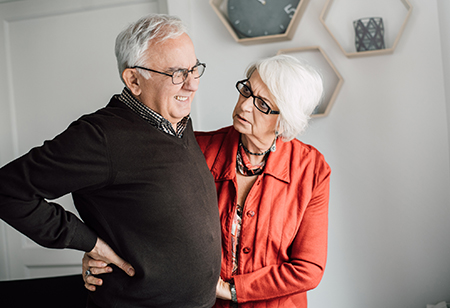
Over the course of your life, your body provides you with support, mobility, comfort and resistance to the rough and tumble of daily existence.
However, your body does slow down as you age. Degenerative conditions such as spinal stenosis, in which the spinal column narrows and loses joint fluid, occur in approximately 95% of the population.
Because spinal stenosis is common as you age, here's a quick look at the condition:
1. Spinal stenosis can result from wear and tear.
Aging can change your skeletal system. For example, spinal stenosis is most commonly caused by regular wear-and-tear changes in the spine as you age.
"Almost everyone gets this degenerative disease of the spine as part of the aging process," said Amber Hennenhoefer, DO, an HonorHealth specialist in physical medicine and rehabilitation. "It's a common diagnosis; however, most people respond to conservative treatments."
The condition is usually classified as one of two types: 1) cervical stenosis in the neck, or 2) lumbar stenosis in the lower back, which is the most common type.
2. Try the shopping cart test.
Common spinal stenosis symptoms include:
- Weakness
- Numbness or tingling in a foot or leg
- Pain or cramping in one or both legs when you stand for long periods of time or when you walk
- Back pain
Pain in your limbs or when sitting is usually what causes you to seek a doctor's advice. A special test can determine if spinal stenosis is the cause.
But one sign of spinal stenosis is more blatant than the rest: "It sounds kind of funny, but we often ask people if they get relief when they lean on a shopping cart. If someone can walk for a longer period of time or with less pain when they're leaning forward on a shopping cart, it's a sign they have the ailment," said Dr. Hennenhoefer.
3. Spinal stenosis can't be cured but responds to treatment.
No one wants to hear that a disease can't yet be cured, but in most cases of spinal stenosis, nothing can make the spinal column go back to the structure it had when you were younger.
But Dr. Hennenhoefer says you can live a normal life with a spinal stenosis diagnosis and can work on improving your mobility and comfort.
"Unfortunately, nothing can stop the progression of spinal stenosis, since it is due to daily wear and tear," said Dr. Hennenhoefer. "The symptoms of spinal stenosis typically respond to conservative treatments, including physical therapy and injections."
"Spinal stenosis is an incredibly complex disorder," said Gianni Vishteh, MD, a neurosurgeon and an independent member of the HonorHealth Medical Staff. "There are entire textbooks written about the topic. Some causes are degenerative, neoplastic (abnormal and excessive growth of tissue), infectious, congenital or deformity. There are multiple treatment modalities for each cause, so talking to a doctor about your situation is important."
4. Physical therapy can help.
The first course of treatment for spinal stenosis is physical therapy along with pain and anti-inflammatory medication.
"In physical therapy, we work on improving mobility and strengthening the core (to support the back)," said Dr. Hennenhoefer. "We also work on flexibility, balance and gait, typically twice a week for six weeks, in combination with medication."
5. Other treatments are also available.
After having spinal stenosis for a long time, or when the condition continues to be very painful, steroid injections are the next option. If injections don't resolve your pain, your next step is to schedule a consult for surgical options.
"Various surgical procedures, including minimally invasive options, can be considered for spinal stenosis if conservative efforts fail," said Dr. Vishteh. "A surgeon can work with you to evaluate the options that would work best for your specific condition."